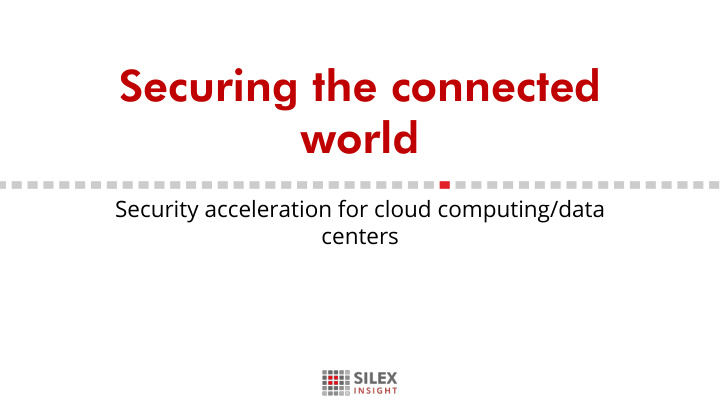



Securing the connected world Security acceleration for cloud computing/data centers
Company history 1991: Founded as ASIC design house in Louvain-la-Neuve, Belgium ▪ 1995: Becomes part of the Barco group. ▪ 1999: 1st SoC development for payment terminal ▪ 2003: Introduction of JPEG2000 IP cores for FPGAs ▪ 2011: Introduction of Public Key and AES cryptographic IP cores ▪ 2015: Technology & Engineering Emmy Award for J2K Interop ▪ 2016: Introduction of VIPER: HDMI over IP OEM board ▪ 2016: Introduction of eSecure: Embedded Security IP ▪ 2018: Barco Silex becomes Silex Insight and part of the Vehold group ▪ Silex Insight today: ▪ ❑ Staff of 35 ❑ ISO 9001-2008
Security markets/applications ▪ End-point, edge computing, data center
Security IP products overview eSecure (HW Root Of Trust, Security Enclave) ▪ Secure Boot ❑ Secure Debugging ❑ Secure Key Storage ❑ Device Authentication ❑ Anti-tampering – Side Channel Attack protection ❑ PUF available ❑ Low power features (retention, power down) ❑ Evita compliant – Crypto Driver API from AUTOSAR for host library ❑ Several processors integrated ❑ RISC-V Controller (from various partners) ARM MIPS Wide range of cryptographic algorithms ❑ Silicon proven ❑ Applications: Automotive, Industrial, Cloud computing, IoT end Node device, Wireless ▪ communications
Security IP products overview MACSec packet processor 400/800 Gbps – Cloud computing ▪ IPSec packet processor 100 Gbps – Cloud computing ▪ IPv4/IPv6 ❑ AES-GCM, Chacha20Poly1305 ❑ Multi PK engine – Cloud computing, Blockchain ▪ TLS/SSL connections offloading co-processor for TLS 1.2 and 1.3 ❑ Crypto currency transaction ❑ V2x certificate generation ❑ Bus Encryption protecting DDR content ▪ In line decryptor ▪ Crypto-Coprocessor ▪ Customization and design services on the security IP products ▪
Supported Cryptographic algorithms Asymmetric algorithms ▪ RSA/DH/DSA/CRT/ECC/ECDSA/ECDH ❑ ECC Curves: NIST, Brainpool, Koblitz, Unrivalled performances & trade-off ▪ Montgomery, Edwards and others… performances/area Apple HomeKit/TLS1.3: Curve25519, EdDSA/Ed448, ❑ SRP Very high level of scalability and ▪ Thread Protocol: J-PAKE ❑ flexibility Rabin-Miller (primality check) and Key Generation ❑ SM2, Ed448, EC-KCDSA, ECIES, ECMQV ❑ Symmetric algorithms Associated Bare-Metal Drivers – ▪ ▪ Integration into lightweight TLS/DTLS AES supporting all modes (GCM, CCM, CFB, CBC…) ❑ lib Very High performance AES-GCM/CTR/XTS > 400 ❑ Gbps 3GPP algorithms (Snow3G, Kasumi, ZUC) All cores share the same AMBA ❑ ▪ Chacha20_poly1305 – TLS 1.3/Apple HomeKit interface ❑ Very High performance Chacha20_poly1305 > 400 ❑ AXI4 stream ❑ Gbps AHB/AXI master ❑ SHA1/2, SM3 Embedded DMA for symmetric algorithms ❑ ❑ SHA-3 ❑ SM4 FIPS 140-2 (level 3/4) / PCI Certification ❑ ▪ 3-DES core ❑ Random Number Generators ▪ TRNG (NIST 800-90B and AIS-31) ❑ DRBG (NIST 800-90A compliant) ❑
Connected world ▪ Data center challenges ❑ High throughput secure data processing ❑ High performance secure connection engine ❑ Requires HW offloading to ASIC or FPGA Reduce power consumption Increase performance Offload processor
High Perf security protocols ▪ IPSec: todays requirements can go up to 100 Gbps ▪ MACSec: todays requirements can go up to 400/800 Gbps ▪ TLS/SSL connections offloading: requires several 10-Ks connections/s
IPsec/MACsec ▪ Data transfer: ❑ Source authentication ❑ Data integrity ❑ Confidentiality → Ipsec/MACsec is the transport security protocol of choice ❑ Software implementations not well suited timing-critical high-throughput applications HW offloading required
IPSec ▪ Scalable solution going up to 100 Gbps ▪ Cryptography algorithms: AES-GCM / Chacha20Poly1305 ▪ Tunnel Mode ▪ Classification ▪ ESP encapsulation ▪ Key size up to 256 bits ▪ IPv4/IPv6
MACsec MACSec Features: ▪ ❑ Datapath from 128 to 1024 bits ❑ Cryptography: AES-GCM- 128/256, AES-GCM-XPN- 128/256 ❑ SecTag encapsulation/decaspulation ❑ ICV calculation/checking ❑ Interface to TCAM ❑ Classification ❑ Scalable solution: from 10 Gbps to 800 Gbps
Secure connection engine ▪ Secure connections ❑ TLS/SSL connections ❑ Requires compute intensive asymmetric cryptography ❑ Software implementations not well suited high number of connections/sec (PK operations) HW offloading required
TLS/SSL connection engine TLS/SSL connections offloading ▪ Several tenths of thousands ❑ connections per second Support for TLS 1.2/1.3 algorithms ❑ (RSA, ECC NIST/Brainpool/X.25519,X.448/EdD SA,Ed448 and others) Can be implemented in FPGA and ❑ ASIC several 10k’s TLS/SSL connections ❑ per second several hundred thousand ECC P- ❑ 256 operation per second Above 1Ghz on latest ASIC ❑ technology, and 600/700 MHz on latest FPGA HW load balancer schedules ❑ optimal use of high performance PK engines
Needs and benefits ▪ HW IPsec/MACsec engine ❑ Very high throughput (800Gbps with one engine) ❑ Host CPU is free for other critical tasks ❑ Improved security ▪ HW TLS/SSL connection engine ❑ Several 10K operations/sec (sign and verify) ❑ Host CPU is free for other critical tasks ▪ FPGA availability in data centers allows for cheap but very efficient implementation
Recommend
More recommend